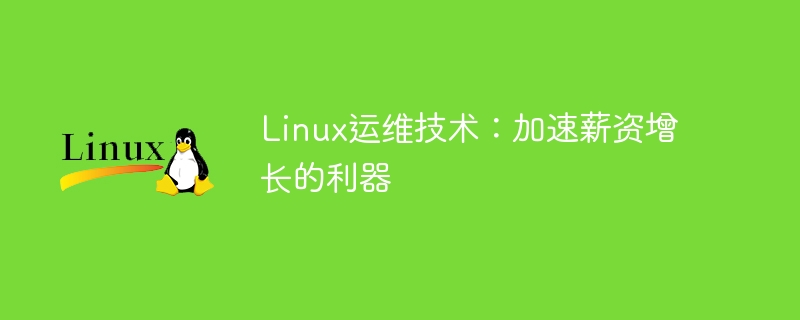Home >Operation and Maintenance >Linux Operation and Maintenance >Linux operation and maintenance technology: a powerful tool to accelerate salary growth
Linux operation and maintenance technology: a powerful tool to accelerate salary growth
- 王林Original
- 2023-09-08 14:46:51701browse

Linux operation and maintenance technology: a powerful tool to accelerate salary growth
It is undeniable that the Linux operating system has become an indispensable part of the IT industry. Mastery of Linux operation and maintenance technology is not only of great significance to personal career development, but also can become a powerful tool to accelerate salary growth.
Linux, as an open source operating system, has excellent stability and security and is widely used in server-side, embedded devices, cloud computing platforms and other fields. With the rapid development of cloud computing and big data technology, the demand for Linux operation and maintenance technical talents is also growing.
Below we will introduce several Linux operation and maintenance technologies worthy of attention and learning to help you improve your skills and promote career development.
- Shell script programming
Shell script programming is one of the basic skills necessary for Linux operation and maintenance personnel. By writing Shell scripts, various system maintenance, task scheduling, log processing and other tasks can be automatically completed to improve work efficiency. The following is a simple shell script example for backing up files in a specified directory.
#!/bin/bash backup_dir="/data/backup" source_dir="/data/www" target_file="backup_$(date +%Y%m%d).tar.gz" tar -czf $backup_dir/$target_file $source_dir
In actual work, we can execute this script regularly through scheduled tasks (crontab) to achieve automatic backup of files.
- Network Service Management
Linux operating system, as a server-side operating system, provides a wealth of network services. It is essential for operation and maintenance personnel to understand and master common network services under Linux, such as HTTP, FTP, DNS, etc., as well as related configuration and management technologies. The following example shows how to configure a simple virtual host through Nginx.
server {
listen 80;
server_name www.example.com;
root /data/www/example;
index index.html;
location / {
try_files $uri $uri/ =404;
}
}By configuring Nginx, we can proxy HTTP requests from www.example.com to the specified directory and return the index.html file.
- Containerization Technology
With the continuous development of containerization technology, Docker has become one of the hottest technologies in the fields of cloud computing and DevOps. By using Docker, applications and their dependencies can be packaged into an independent container to achieve cross-platform application deployment and management.
The following is a simple Dockerfile example for building a Ubuntu-based Node.js running environment.
FROM ubuntu:latest RUN apt-get update && apt-get install -y nodejs npm WORKDIR /app COPY . . RUN npm install EXPOSE 8080 CMD [ "npm", "start" ]
By writing a Dockerfile and using Docker commands to build and run, we can quickly deploy a Node.js application and achieve application isolation and expansion.
The above is just the tip of the iceberg of Linux operation and maintenance technology. In actual work, there are many other knowledge and skills worth learning, such as system monitoring, performance tuning, security hardening, etc. Through continuous learning and practice, continuously improving your Linux operation and maintenance technology can not only pave the way for personal career development, but also become a powerful tool to accelerate salary growth.
To sum up, by learning Linux operation and maintenance technologies such as Shell script programming, network service management, and containerization technology, we can master the skills commonly used in actual work, improve work efficiency, and prepare for personal career development. I believe that as skills improve, salary increases will follow naturally.
Come on, Linux operation and maintenance experts!
The above is the detailed content of Linux operation and maintenance technology: a powerful tool to accelerate salary growth. For more information, please follow other related articles on the PHP Chinese website!

